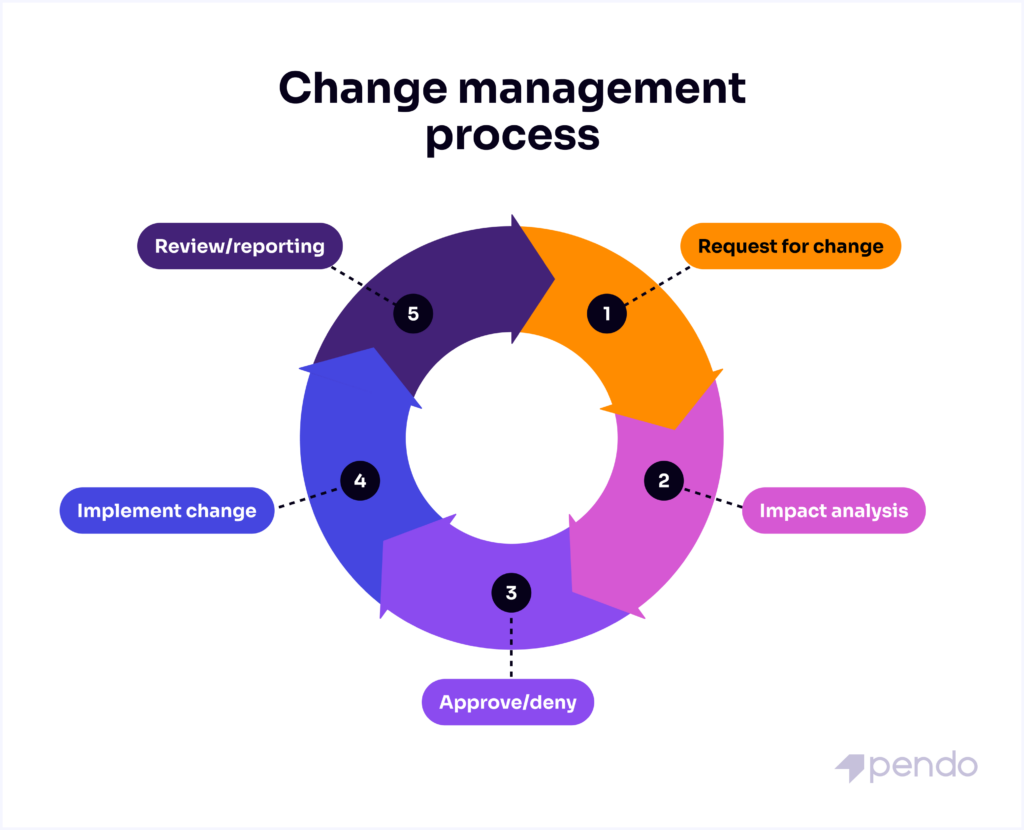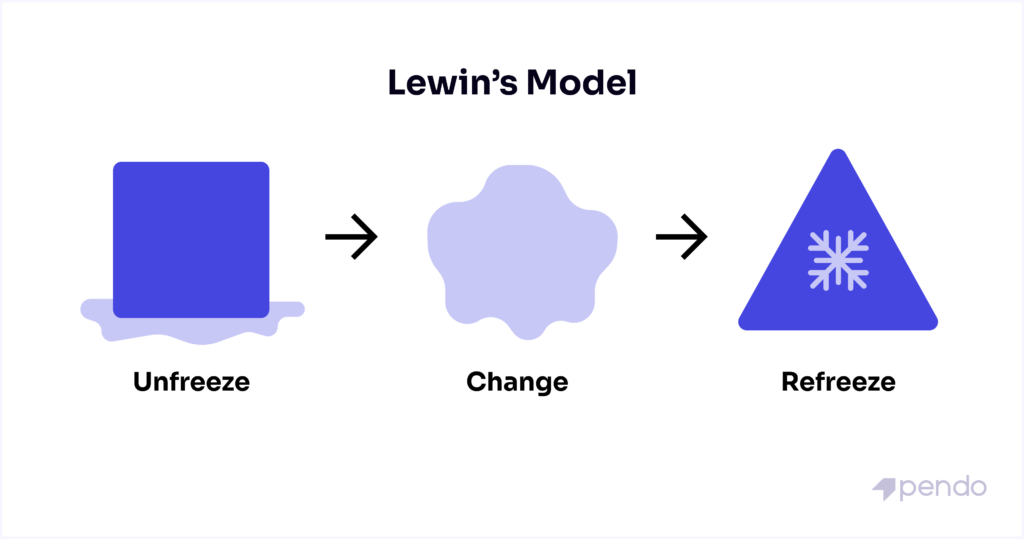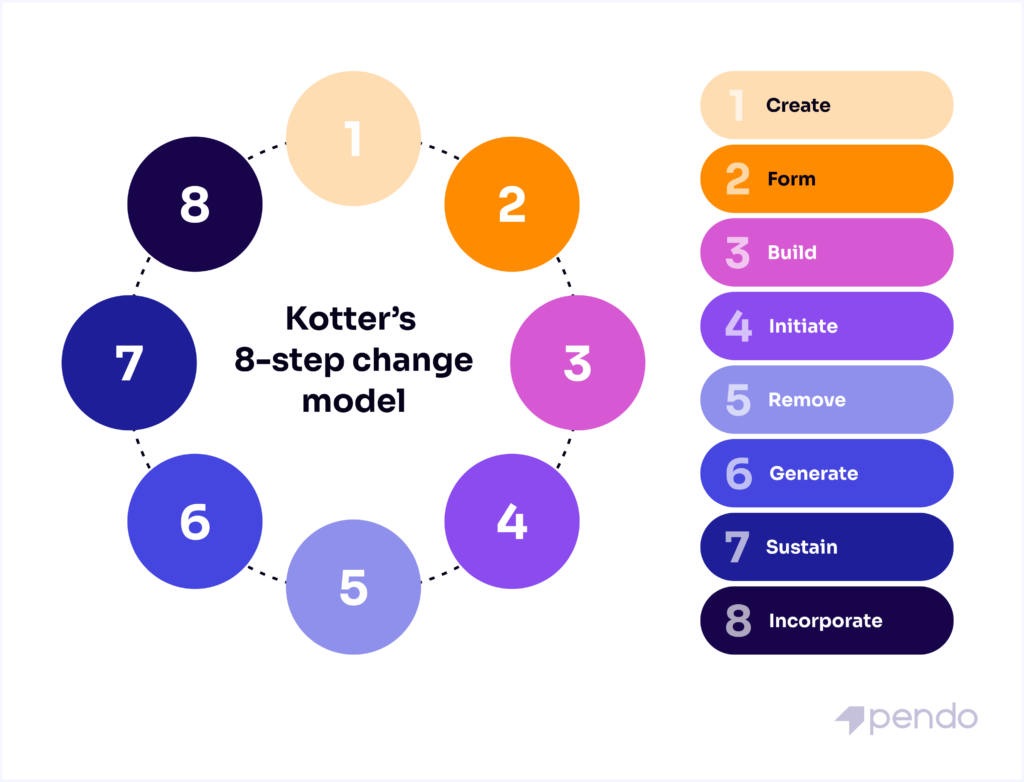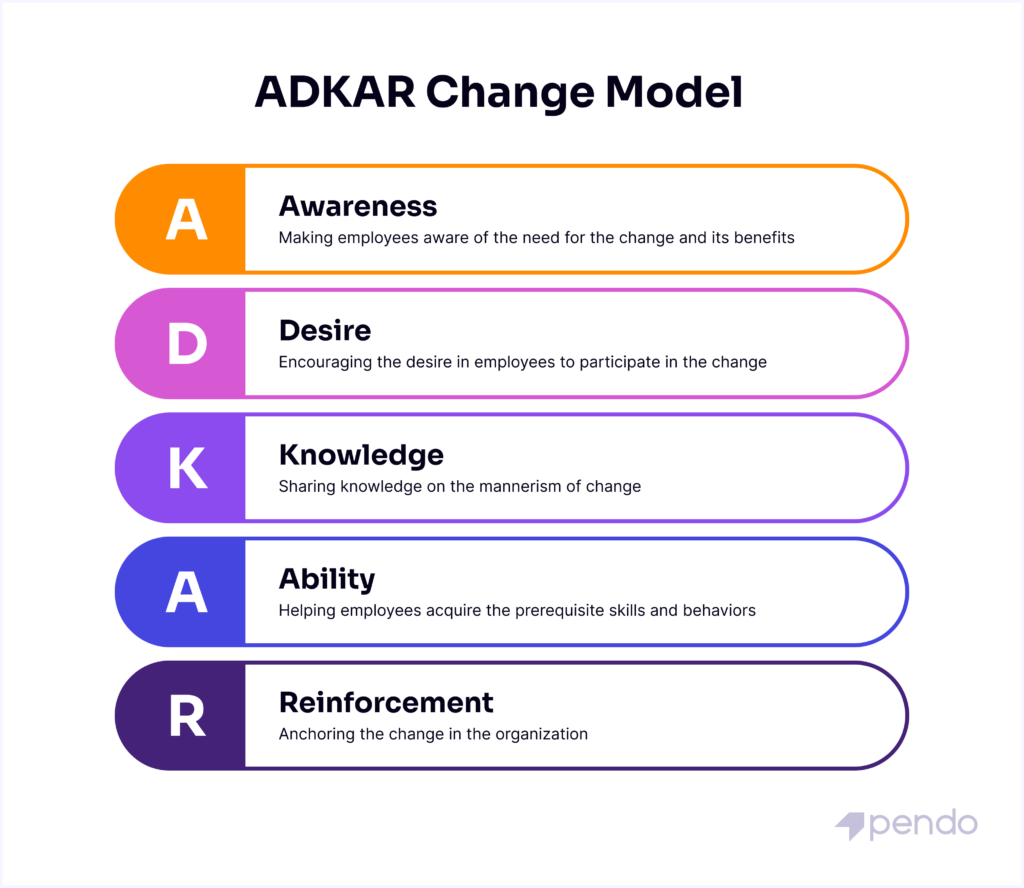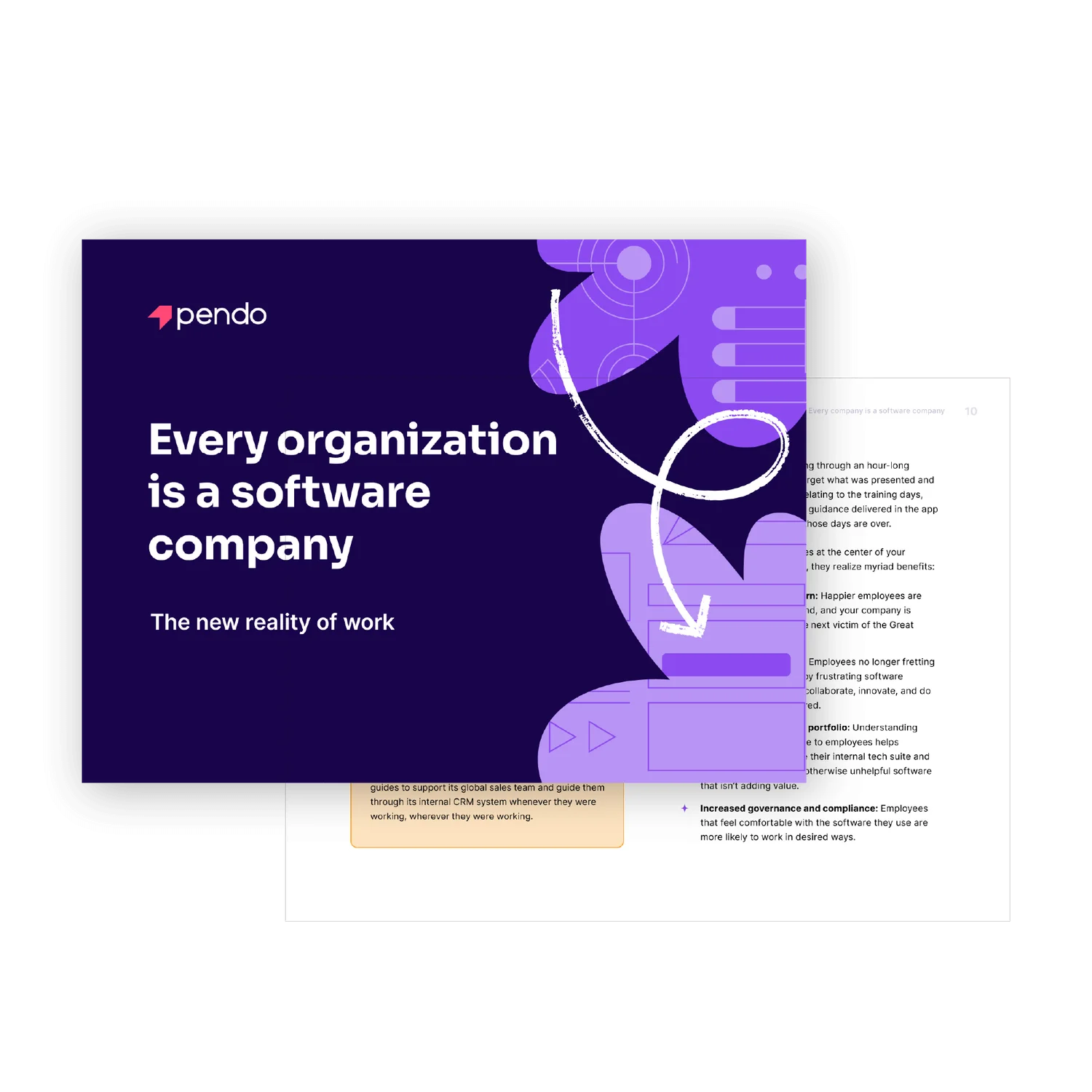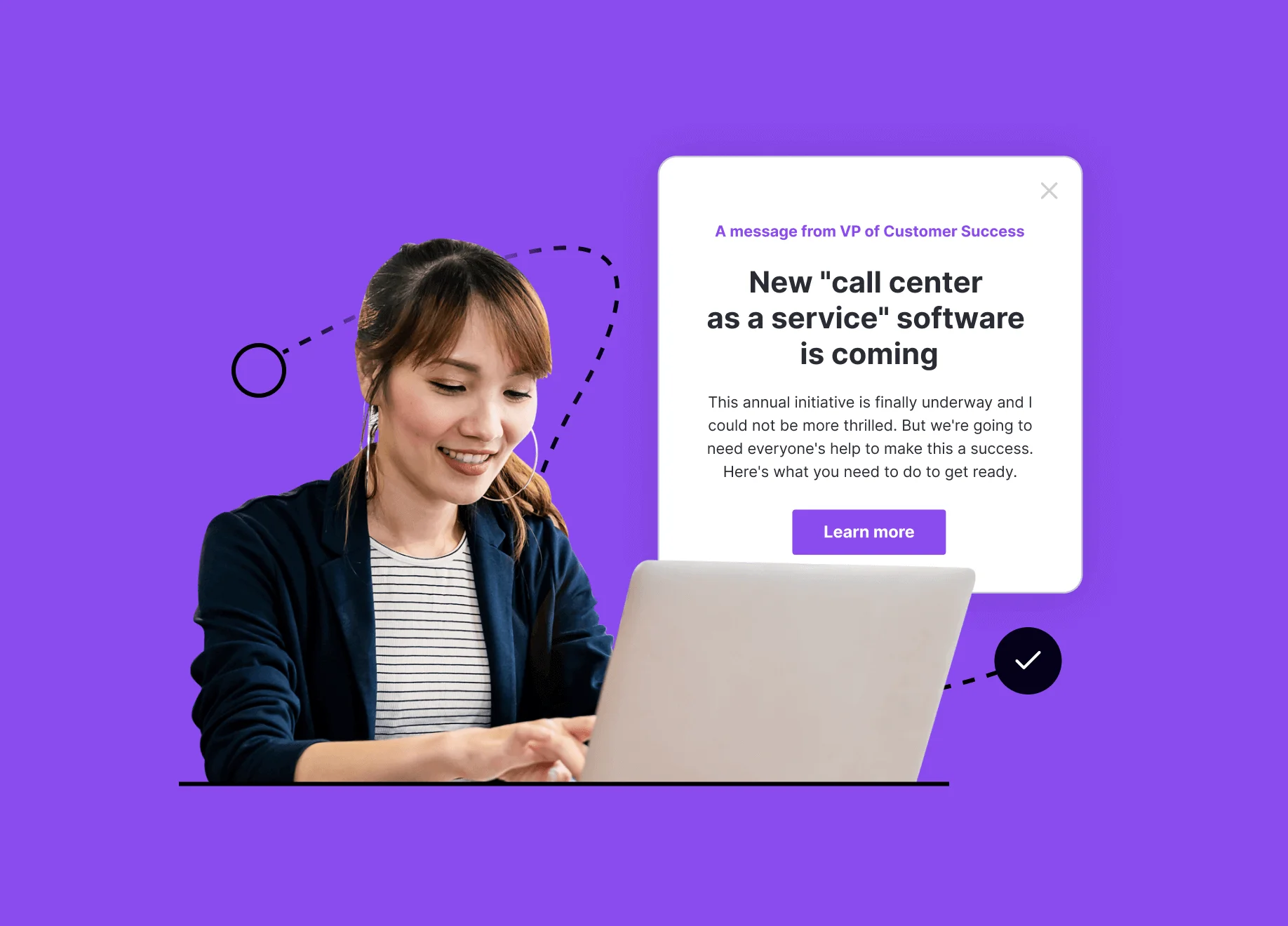
深掘り - 読了目安:11分
変更管理とは
変更管理とは、個人、チーム、組織を、現在の関わり方、働き方、運営方法から望ましい将来像を実現するために構造化されたアプローチです。このアプローチでは、変化への抵抗を最小限に抑え、新しいプログラム、プロダクト、プロセス、フィーチャーの定着率と効果を最大化するための変更内容の計画、実装、監視などが行われます。
さらに深く掘り下げる
目次
As software becomes more central to how employees work, change management has become increasingly synonymous with managing digital change, specifically with digital adoption of new applications and cross-application workflows critical to success.
変更管理が重要である理由
どのような組織においても変化は避けられません。企業が変化する市場やデジタル化が進む職場に適応していくためには、効果的に変更を管理することが極めて重要です。ただし、構造化されたアプローチを用いずに変化に対処すると、重大な悪影響が生じる可能性があります。
変更管理の実践が不十分な組織では、プロジェクトの完全な失敗ではないにしても、変更の取り組みにおいて大幅なコスト超過がしばしば発生します(さらには売上や市場の信頼性を失うことさえあります)。 抵抗、混乱、フラストレーションはあっという間に雪だるま式に膨れ上がり、従業員の士気から財務実績まですべてに影響を与える可能性があります。 大規模な小売チェーンが、適切なコミュニケーションやトレーニングを受けずに新しい在庫管理システムを導入していると想像してみてください。 従業員が最新のソフトウェアを使いこなせず混乱していると、不正確な在庫量、注文の遅れ、顧客の不満につながり、最終的には売上を失い、ブランドの評判が低下することになります。
変更の大小を問わず、変更管理によって、混乱を最小限に抑えて円滑な変更が行われ、個人とチームが変更管理プロセスを通じて十分な準備とサポートを受けられるようになります。
変更管理の主な目的
変更管理の主な目的は以下のとおりです。
- 変化への抵抗を最小限に抑える:未知なるものへの恐怖、潜在的な雇用不安、または確立されたルーチンの混乱のために、従業員が変化に抵抗するのは当然のことです。 これに対処するには、明確かつ早期にコミュニケーションを取り、変更プロセスへの従業員の関与を促し、ユーザーの不安を予測して準備する必要があります。
- Maximizing the adoption and acceptance of change: To embrace the change, users must understand and feel comfortable with the new system or process. To ensure this acceptance, design user-friendly interfaces and provide comprehensive, ongoing support that includes in-app guides and other self-service assistance to empower users to succeed.
- Minimizing disruptions to business operations: The goal is to transition smoothly without hindering ongoing work. Create and follow a clear communications plan to inform users before, during, and after the implementation about the change, its impact, and resources available for support. As mentioned before, anticipate challenges during the rollout and have contingency plans ready if they happen. For large-scale changes, consider phased rollouts so users have time to adjust.
- Accelerating the pace of change implementation: Timely implementation minimizes uncertainty and allows employees to reap the benefits of the change sooner. To streamline things, identify and remove any bureaucratic hurdles and unnecessary or redundant tasks. Empower employees who are enthusiastic about the change to act as advocates and support their colleagues. Above all, leverage available technology, including communication and digital adoption platforms, to deliver information and training materials efficiently.
- Optimizing the benefits and outcomes of change initiatives: Effective change management is an ongoing process that should be one of continuous improvement. Measure your success by establishing key performance indicators (KPIs) to track the effectiveness of the change and identify areas for improvement. Solicit ongoing feedback from employees to gauge their experience. For both KPIs and feedback you collect, be prepared to make adjustments to ensure the change ultimately achieves its intended goals.
変更管理のメリット
効果的な変更管理とは、単に新しいソフトウェアや機能を導入することだけではありません。組織内でこれらを成功させ、持続可能にすることが目的なのです。明確に定義された変更管理戦略の魅力的なメリットをいくつかご紹介します。
- Increased efficiency: Smoothly implemented changes can streamline workflows, eliminate redundancies, and improve productivity.
- Enhanced innovation: A culture that embraces change fosters creativity and encourages the exploration of new ideas and solutions.
- Improved employee satisfaction: When employees understand the reasons for change and are involved in the process, they are more likely to be supportive and engaged.
- Better adaptability to market changes: Organizations that adapt quickly to market shifts and evolving customer needs gain a competitive advantage.
- Reduced costs: Effective change management can minimize disruptions and setbacks, leading to cost savings in the long run.
これらのメリットはすべて、組織が変化を円滑かつ効果的に乗り切るために準備を整え、最終的に望ましい将来像を実現するのに役立ちます。
変更管理プロセスの段階
構造化された変更管理プロセスは、現在の状態から望ましい将来像への移行を導きます。ここでは、スムーズかつ成果を出せるジャーニーのためのベストプラクティスを取り入れた、主要な段階を詳しくご紹介します。
1. Planning: Identifying the need for change, defining objectives, and creating a change management plan:
- Define clear goals: Outline the specific objectives the change aims to achieve to measure success effectively.
- Identify stakeholders: Pinpoint everyone impacted by the change, including employees, managers, customers, and external partners.
- Conduct risk assessments: Proactively identify potential challenges and develop mitigation plans.
2.Communication: Informing stakeholders about the change, addressing concerns, and ensuring clarity of purpose
- Tailored communication plans: Craft clear, concise messages to target and address the concerns and interests of different stakeholder groups.
- Transparency is key: Be open and honest about the change, its timeline, and its rationale.
- Utilize multiple channels: Leverage various communication channels like town halls, emails, and internal communication platforms to reach everyone effectively.
3. Preparation: Assessing the impact of change, identifying risks, and developing strategies to mitigate them
- Invest in training: Equip employees with the knowledge and skills needed to utilize the change effectively through comprehensive training programs, including in-app guides and support.
- Allocate resources: Secure the resources needed, such as budget, technology, and personnel, to support the change implementation.
- Develop contingency plans: Anticipate potential roadblocks and develop alternative strategies to address them promptly.
4. Implementation: Executing the change plan, monitoring progress, and making adjustments as necessary
- Monitor progress: Track progress against established goals and identify areas where adjustments might be necessary.
- Embrace flexibility: Be prepared to adapt your approach based on real-time feedback and unforeseen challenges.
- Address issues proactively: Address problems swiftly and transparently to maintain employee confidence.
5. Reinforcement: Consolidating the change, celebrating successes, and embedding new behaviors and practices
- Promote new behaviors: Encourage and recognize the adoption of new behaviors and workflows aligned with the change initiative.
- Celebrate successes: Acknowledge milestones and achievements to maintain momentum and employee engagement.
- Continuous improvement: Establish feedback mechanisms to gather input and identify areas for continuous improvement to ensure the sustainability of the change.
各段階でこれらの手順とベストプラクティスに従うことで、組織は綿密に計画され、十分なコミュニケーションが行われ、十分にサポートされた移行を確実に行うことができ、変化への取り組みによるプラスの影響を最大化できます。
一般的な変更管理モデル
主な変更管理モデルは以下のとおりです。
- Lewin’s Change Management Model:
- This model, developed by Kurt Lewin, emphasizes the need to address resistance and create stability after change. To do so, it proposes a three-stage process: unfreeze (prepare for change by analyzing the current state), change (implement the new approach), and refreeze (solidify the change as the new normal). This model is well-suited for addressing relatively simple or well-defined changes.
- Kotter’s 8-Step Change Model:
- Developed by John Kotter, this model provides a more comprehensive step-by-step approach to change. It outlines eight key steps for leading successful change, including creating a sense of urgency, building a guiding coalition, developing a vision for change, empowering action, and anchoring the change in the organization’s culture. This model is valuable for complex, organization-wide changes.
- ADKAR Model:
- This model focuses on individual change, highlighting five elements essential for successful change adoption. These include awareness (of the need for change), desire (to participate in the change), knowledge (of how to implement the change), ability (to put the knowledge into practice), and reinforcement (to sustain the change over time). This model is particularly useful for initiatives requiring significant employee behavioral changes.
変化への抵抗とは
変化への抵抗とは、変化に直面したときに個人や集団が示す抵抗感または反対意見を指します。これは、懐疑、恐怖、現状維持の願望などのさまざまな形で現れます。変更管理を成功させるには、抵抗について理解し、対処することが重要です。
変化への抵抗の管理方法
変化への抵抗を管理するには、積極的かつ共感的なアプローチが必要です。抵抗に対処するための戦略は以下のとおりです。
- 効果的なコミュニケーション:変更の理由、メリット、影響を明確に伝達し、懸念事項に対処し、質問に回答する
- 関与と参加:従業員を変更プロセスに関与させて意見やフィードバックを求め、オーナーシップとコミットメントを高める
- 教育とトレーニング:変更に適応するために必要なスキルと知識を開発するトレーニングやリソースを提供する
- 変更の推進者:変更について提唱し、抵抗への対処を支援できる組織内の変更の推進者を特定して権限を与える
- 動機と報酬:変更を受容・支持する個人やチームを評価して報酬を与え、前向きな行動を促す
変更の推進者とは
変更の推進者とは、変更管理プロセスを主導・促進する責任を負う個人またはグループを指します。変更の推進者は組織の内外に存在し、変革を導き、ステークホルダーを巻き込み、変更への取り組みの実装を促進する上で重要な役割を果たします。
変更管理計画書とは
変更管理計画書は、特定の変更への取り組みを管理するために必要な戦略、活動、リソースを概説する文書です。典型的な計画書には、現状の評価、目標と目的、ステークホルダー分析、コミュニケーション計画、トレーニングとサポートの戦略、実装までのスケジュールなどが含まれます。
ステークホルダー分析とは
ステークホルダー分析は、変更の影響を受ける個人、グループ、組織を特定および評価するプロセスです。これは、ステークホルダーの関心事項、影響力、変更に対する潜在的な反応を理解するのに役立ち、対象を絞ったコミュニケーションやエンゲージメント戦略の開発を可能にします。
変更管理におけるリーダーシップの役割
リーダーシップは変更管理において重要な役割を果たします。有能なリーダーは、ビジョンを提供し、従業員にインスピレーションとモチベーションを与え、変更を支援する環境を整備できます。リーダーは明確な期待値を設定し、変更の必要性を伝達し、変更への取り組みを積極的にサポートします。
変更管理とプロジェクト管理の違い
変更管理とプロジェクト管理は関連していますが、その目的が異なります。プロジェクト管理は、あらかじめ定義された目標を達成するためのプロジェクトの計画、実行、制御に焦点を当てます。変更管理は、変更の人的側面の管理、抵抗への対処、プロジェクトや取り組み全体で変更を確実に定着化させることに重きを置きます。
変更管理の主な成功要因
変更管理の主な成功要因は以下のとおりです。
- 強力なリーダーシップとスポンサーシップ
- 効果的なコミュニケーションとエンゲージメント
- 従業員の関与と参加
- 適切なトレーニングとサポート
- 明確な目標と目的
- 柔軟性と適応性
- 継続的なモニタリングと評価
- 成功の祝福と強化
変更管理にかかる時間
変更管理にかかる期間は、変更の複雑さと範囲によって異なります。変更に数週間から数か月かかる場合も、数年にわたる場合もあります。変更の実装を確実に成功させるには、計画、実行、強化のプロセスに十分な時間を割り当てることが不可欠です。
抵抗管理とは
抵抗管理とは、変化への抵抗を特定・理解し、それに対処するプロセスを指します。これには、効果的なコミュニケーション、関与、教育、個々の懸念事項への対処など、抵抗を軽減するための積極的な対策が含まれます。抵抗管理により、変更がうまく定着化する可能性が高まります。
変更レディネス評価とは
変更レディネス評価とは、組織または個人の変更に対する準備の程度を評価するプロセスを指します。組織文化、リーダーシップの支援、従業員エンゲージメント、変更を受け入れるキャパシティなどの各要素を評価して潜在的な障壁を特定し、それに対処する戦略を立てます。
徹底的かつ正確な変更レディネス評価を実施するために、企業は現状と業務の流れを把握する目的で、ますますプロダクトおよびプロセス分析を活用するようになっています。この評価は、ただ単に従業員が期待どおりに行動していると推測するのではなく、従業員が実際にソフトウェアとそこでのプロセスにどう関与しているかを理解するために行います。
企業がデジタルアダプションソリューションを活用して効果的に変更を管理する方法
The analytics capabilities the best digital adoption solutions offer are key to measuring and understanding the current state of work. With the power of these analytics, managers can come to insights that identify areas of the app to reconfigure, change, or create enablement for. They can understand how power users use the product in order to get other users to the same point.
The right digital adoption solution also offers the ability to easily create and deploy in-app and cross-app walkthroughs to guide users through ideal behaviors and workflows, as well as comprehensive feedback management to make sure users feel heard and supported throughout the change process.
デジタルアダプションソリューションを活用して変更を成功へと導くメリット
変更管理計画の一環としてデジタルアダプションソリューションを効果的に活用する主なメリットは、以下のとおりです。
- Increased user retention/decreased user churn – Digital adoption solutions equip employees and customers with the knowledge and skills they need to succeed with new technologies quickly and easily, reducing frustration and increasing confidence, leading to higher retention rates.
- Increased user satisfaction – Digital adoption solutions provide contextual in-app guidance and support, allowing users to learn and work efficiently without needing to constantly seek help. This reduces stress and builds a sense of accomplishment, leading to greater satisfaction.
- Greater user productivity – Digital adoption solutions automate repetitive tasks and streamline workflows, freeing employees’ time to focus on higher-value activities. Additionally, by ensuring everyone is using the software effectively, the solution minimizes wasted time and effort.
- Lower IT and customer support costs – Digital adoption solutions empower users to self-serve by providing readily available resources and guidance within the software. This reduces the burden on IT and customer support teams, allowing them to focus on more complex issues and strategic initiatives.
変更管理におけるコミュニケーションの役割
コミュニケーションは変更管理に不可欠な要素です。効果的なコミュニケーションは、意識を高め、理解を深め、懸念事項に対処し、ステークホルダーのエンゲージメントと賛同を強化するのに役立ちます。変更プロセス全体を通じて、明確かつタイムリーで、透明性があり、多様なオーディエンスのニーズに合わせて調整されたコミュニケーションが求められます。
Companies can leverage the in-app guidance of a digital adoption solution to keep users up to speed on the pace of change and what developments to expect when. What’s more, communication is a two-way street. The same solution that change management teams use to send notices to users can be used to solicit communication from employees about how change is going—what’s working well, what needs to be changed, and what to prioritize in the change roadmap.
積極的な変更管理と消極的な変更管理の違い
積極的な変更管理とは、将来の変更を予測して計画し、積極的に機会を特定し、計画的かつ戦略的な方法で変更を実装することを指します。一方、消極的な変更管理とは、予期せぬ出来事や危機への対応を指します。これには、状況に対処するための迅速な意思決定とアクションが求められます。
変更管理プロセスとは
変更管理プロセスは、プロジェクト、システム、組織に対する変更を管理・文書化するための正式な手順です。これには、変更リクエストとその変更に伴う影響を評価し、提案された変更の承認、拒否、修正の是非について情報に基づく決定を下すことが含まれます。変更管理プロセスにより変更が適切に評価・管理され、リスクは最小限に抑えられ、プロジェクトや組織の整合性が維持されます。
変更管理におけるトレーニングと能力開発の役割
トレーニングと能力開発は、変更への適応と支援に求められる知識、スキル、能力を従業員に提供することで、変化管理において重要な役割を果たします。トレーニングプログラムには、ワークショップ、セミナー、eラーニングモジュール、実地研修(OJT)などが含まれ、変更プロセスにおける個人やチームの能力強化を図ります。
Companies looking to automate and deploy training at scale to users are increasingly leveraging digital adoption solutions, the capabilities of which allow for segmented, customized training and onboarding that users can access in the app itself, whenever is convenient for them. Unlike traditional onboarding and training methods, digital adoption solutions allow users to access the material they need at any point, so there is no risk of a user forgetting what they’ve learned or getting stuck due to lack of context or knowledge.
変更の持続可能性とは
変更の持続可能性とは、最初の実装段階後に組織や個人が狙いどおりに変更を維持し、組み込むことのできる長期的な能力を指します。これを実現するには、新しい行動を強化し、進捗状況を監視し、継続的な支援とリソースを提供し、組織の文化やプロセスに変化を統合して永続的な影響を確保する必要があります。
変更管理におけるフィードバックと評価の役割
Feedback and evaluation are essential components of change management. They provide insights into the effectiveness of change initiatives, identify areas for improvement, and help measure progress towards desired outcomes. Regular feedback and evaluation allow for adjustments and course corrections throughout the change process to ensure optimal results. Companies undertaking change management today frequently turn to digital adoption solutions as a central source of truth for collecting and managing employee and user feedback.
変更の飽和とは
変更の飽和とは、個人や組織が同時または短期間に過剰な量の変更を取り入れる状態を指します。これにより、変更による疲労、生産性の低下、抵抗の増大を招く可能性があります。変更の飽和を管理するには、変更の優先順位と順序を決定し、適切な支援を提供し、個人とシステムが互いに調整・適応できるよう十分な時間を確保することが必要です。
変更管理におけるテクノロジーの役割
テクノロジーは、コミュニケーション、コラボレーション、変更の実装を促進することで、変更管理における重要な役割を果たします。デジタルアダプションソリューションなどのツールは、変更プロセスを合理化し、エンゲージメントを強化し、変更実装時にバーチャルチームや物理的に分散したチーム同士を支援できます。
組織における変更文化の役割
組織における変更文化とは、変更に関する組織の集団態度、価値観、行動を指します。ポジティブな変更文化は、変化を受容して支援するための開放性、順応性、意欲を育みます。このような文化は、リーダーシップ、コミュニケーション、従業員エンゲージメント、意図した変更を一貫して強化していくことで培われます。
変更による疲労とは
変更による疲労とは、頻繁な変更または長期にわたる変更が続いた結果、個人や組織が感じる疲弊または倦怠感を指します。これにより、モチベーションの低下、抵抗の増大、パフォーマンスの低下を招く可能性があります。変更による疲労を管理するには、変更の優先順位を決定し、適切な支援とリソースを提供し、安定性と変更のバランスを取る必要があります。
変更管理におけるリスク管理の役割
変更管理におけるリスク管理とは、変更に伴う潜在的なリスクや不確実性を特定、評価、軽減することを指します。これにより、潜在的な障壁を予測して対処し、緊急時対応計画を策定し、混乱や悪影響を最小限に抑えながら円滑に変更を実装できるようになります。
変更管理における組織学習の役割
組織学習は、組織内で知識を獲得、共有、適用するプロセスです。変更管理における組織学習では、学んだ教訓を把握し、ベストプラクティスを特定し、過去の変更の経験を活かして今後の変更への取り組みを強化することが求められます。これにより、継続的な改善、適応力、変更を効果的に管理する能力が促進されます。
A product experience platform makes it easy to have a single source of truth for organizational learning, in the form of a Resource Center or other centralized repository for knowledge management.
変更管理について詳しく学ぶには
Pendo has published resources on the KPIs change management teams should track in the digital workplace and the importance of the right digital adoption solution for driving effective change management.
